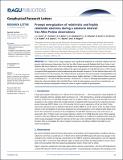| dc.contributor.author | Baker, D. N. | |
| dc.contributor.author | Claudepierre, S. G. | |
| dc.contributor.author | Kletzing, C. A. | |
| dc.contributor.author | Kurth, W. | |
| dc.contributor.author | Reeves, G. D. | |
| dc.contributor.author | Thaller, S. A. | |
| dc.contributor.author | Spence, H. E. | |
| dc.contributor.author | Shprits, Y. Y. | |
| dc.contributor.author | Wygant, J. R. | |
| dc.contributor.author | Foster, John C | |
| dc.contributor.author | Erickson, Philip J | |
| dc.date.accessioned | 2017-05-23T14:38:13Z | |
| dc.date.available | 2017-05-23T14:38:13Z | |
| dc.date.issued | 2014-01 | |
| dc.date.submitted | 2013-11 | |
| dc.identifier.issn | 00948276 | |
| dc.identifier.uri | http://hdl.handle.net/1721.1/109288 | |
| dc.description.abstract | On 17 March 2013, a large magnetic storm significantly depleted the multi-MeV radiation belt. We present multi-instrument observations from the Van Allen Probes spacecraft Radiat ion Belt Storm Probe A and Radiation Belt Storm Probe B at ~6 Re in the midnight sector magnetosphere and from ground-based ionospheric sensors during a substorm dipolarization followed by rapid reenergization of multi-MeV electrons. A 50% increase in magnetic field magnitude occurred simultaneously with dramatic increases in 100 keV electron fluxes and a 100 times increase in VLF wave intensity. The 100 keV electrons and intense VLF waves provide a seed population and energy source for subsequent radiation belt enhancements. Highly relativistic (>2 MeV) electron fluxes increased immediately at L* ~ 4.5 and 4.5 MeV flux increased >90 times at L* = 4 over 5 h. Although plasmasphere expansion brings the enhanced radiation belt multi-MeV fluxes inside the plasmasphere several hours postsubstorm, we localize their prompt reenergization during the event to regions outside the plasmasphere. | en_US |
| dc.description.sponsorship | University of Minnesota (Van Allen Probes subaward to Massachusetts Institute of Technology) | en_US |
| dc.description.sponsorship | United States. National Aeronautics and Space Administration (Prime contract NAS5-01072) | en_US |
| dc.description.sponsorship | United States. National Aeronautics and Space Administration (grant NNX10AK99G) | en_US |
| dc.description.sponsorship | United States. National Aeronautics and Space Administration (grant NNX13AE34G) | en_US |
| dc.description.sponsorship | United States. National Aeronautics and Space Administration (grant NNX09AF51G) | en_US |
| dc.description.sponsorship | National Science Foundation (U.S.) (grant AGS-1203747) | en_US |
| dc.language.iso | en_US | |
| dc.publisher | American Geophysical Union (AGU) | en_US |
| dc.relation.isversionof | http://dx.doi.org/10.1002/2013GL058438 | en_US |
| dc.rights | Article is made available in accordance with the publisher's policy and may be subject to US copyright law. Please refer to the publisher's site for terms of use. | en_US |
| dc.source | Foster | en_US |
| dc.title | Prompt energization of relativistic and highly relativistic electrons during a substorm interval: Van Allen Probes observations | en_US |
| dc.type | Article | en_US |
| dc.identifier.citation | Foster, J. C., P. J. Erickson, D. N. Baker, S. G. Claudepierre, C. A. Kletzing, W. Kurth, G. D. Reeves, et al. “Prompt Energization of Relativistic and Highly Relativistic Electrons During a Substorm Interval: Van Allen Probes Observations.” Geophysical Research Letters 41, no. 1 (January 15, 2014): 20–25. | en_US |
| dc.contributor.department | Haystack Observatory | en_US |
| dc.contributor.approver | Foster, John C. | en_US |
| dc.contributor.mitauthor | Foster, John C | |
| dc.contributor.mitauthor | Erickson, Philip J | |
| dc.relation.journal | Geophysical Research Letters | en_US |
| dc.eprint.version | Final published version | en_US |
| dc.type.uri | http://purl.org/eprint/type/JournalArticle | en_US |
| eprint.status | http://purl.org/eprint/status/PeerReviewed | en_US |
| dspace.orderedauthors | Foster, J. C.; Erickson, P. J.; Baker, D. N.; Claudepierre, S. G.; Kletzing, C. A.; Kurth, W.; Reeves, G. D.; Thaller, S. A.; Spence, H. E.; Shprits, Y. Y.; Wygant, J. R. | en_US |
| dspace.embargo.terms | N | en_US |
| mit.license | PUBLISHER_POLICY | en_US |
